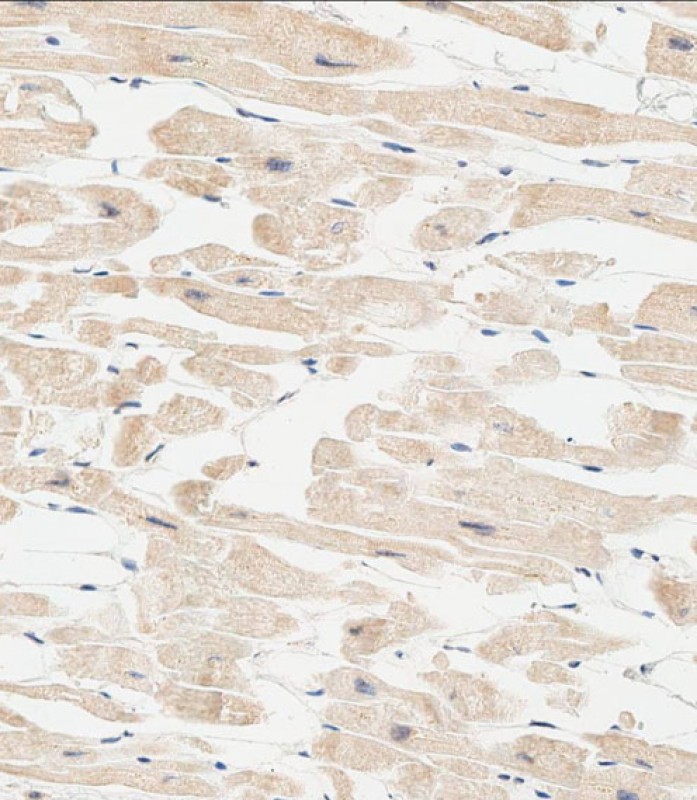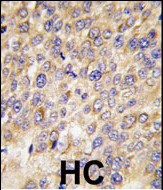GABARAP Antibody (N-term)
Affinity Purified Rabbit Polyclonal Antibody (Pab)
- 产品详情
- 文献引用 : 12
- 实验流程
- 背景知识
Application
| WB, IHC-P, IF, IHC-P-Leica, E |
|---|---|
| Primary Accession | O95166 |
| Other Accession | P60517, Q8MK68, Q9DCD6, Q9GJW7 |
| Reactivity | Human, Mouse, Rat |
| Predicted | Mouse, Rat, Rabbit, Bovine |
| Host | Rabbit |
| Clonality | Polyclonal |
| Isotype | Rabbit IgG |
| Calculated MW | 13918 Da |
| Antigen Region | 1-30 aa |
| Gene ID | 11337 |
|---|---|
| Other Names | Gamma-aminobutyric acid receptor-associated protein, GABA(A) receptor-associated protein, MM46, GABARAP, FLC3B |
| Target/Specificity | This GABARAP antibody is generated from rabbits immunized with a KLH conjugated synthetic peptide between 1-30 amino acids of human GABARAP. |
| Dilution | WB~~1:8000 IHC-P~~1:100~500 IF~~1:500 IHC-P-Leica~~1:500 E~~Use at an assay dependent concentration. |
| Format | Purified polyclonal antibody supplied in PBS with 0.09% (W/V) sodium azide. This antibody is purified through a protein A column, followed by peptide affinity purification. |
| Storage | Maintain refrigerated at 2-8°C for up to 2 weeks. For long term storage store at -20°C in small aliquots to prevent freeze-thaw cycles. |
| Precautions | GABARAP Antibody (N-term) is for research use only and not for use in diagnostic or therapeutic procedures. |
| Name | GABARAP (HGNC:4067) |
|---|---|
| Synonyms | FLC3B |
| Function | Ubiquitin-like modifier that plays a role in intracellular transport of GABA(A) receptors and its interaction with the cytoskeleton (PubMed:9892355). Involved in autophagy: while LC3s are involved in elongation of the phagophore membrane, the GABARAP/GATE-16 subfamily is essential for a later stage in autophagosome maturation (PubMed:15169837, PubMed:20562859, PubMed:22948227). Through its interaction with the reticulophagy receptor TEX264, participates in the remodeling of subdomains of the endoplasmic reticulum into autophagosomes upon nutrient stress, which then fuse with lysosomes for endoplasmic reticulum turnover (PubMed:31006538). Also required for the local activation of the CUL3(KBTBD6/7) E3 ubiquitin ligase complex, regulating ubiquitination and degradation of TIAM1, a guanyl-nucleotide exchange factor (GEF) that activates RAC1 and downstream signal transduction (PubMed:25684205). Thereby, regulates different biological processes including the organization of the cytoskeleton, cell migration and proliferation (PubMed:25684205). Involved in apoptosis (PubMed:15977068). |
| Cellular Location | Cytoplasmic vesicle, autophagosome membrane. Endomembrane system {ECO:0000250|UniProtKB:P60517}. Cytoplasm, cytoskeleton {ECO:0000250|UniProtKB:P60517}. Golgi apparatus membrane {ECO:0000250|UniProtKB:P60517}. Cytoplasmic vesicle {ECO:0000250|UniProtKB:P60517}. Note=Largely associated with intracellular membrane structures including the Golgi apparatus and postsynaptic cisternae. Colocalizes with microtubules (By similarity) Also localizes to discrete punctae along the ciliary axoneme (By similarity). {ECO:0000250|UniProtKB:P60517, ECO:0000250|UniProtKB:Q9DCD6} |
| Tissue Location | Heart, brain, placenta, liver, skeletal muscle, kidney and pancreas. |
For Research Use Only. Not For Use In Diagnostic Procedures.

Provided below are standard protocols that you may find useful for product applications.
BACKGROUND
Gamma-aminobutyric acid A receptors [GABA(A) receptors] are ligand-gated chloride channels that mediate inhibitory neurotransmission. GABARAP is GABA(A) receptor-associated protein, which is highly positively charged in its N-terminus and shares sequence similarity with light chain-3 of microtubule-associated proteins 1A and 1B. This protein clusters neurotransmitter receptors by mediating interaction with the cytoskeleton.
REFERENCES
References for protein:
1.Nemos, C., et al., Brain Res. Mol. Brain Res. 119(2):216-219 (2003).
2.Stangler, T., et al., J. Biol. Chem. 277(16):13363-13366 (2002).
3.Knight, D., et al., J. Biol. Chem. 277(7):5556-5561 (2002).
4.Tanida, I., et al., J. Biol. Chem. 277(16):13739-13744 (2002).
5.Harris, R., et al., J. Biomol. NMR 21(2):185-186 (2001).
References for U251 cell line:
1. Westermark B.; Pontén J.; Hugosson R. (1973).” Determinants for the establishment of permanent tissue culture lines from human gliomas”. Acta Pathol Microbiol Scand A. 81:791-805. [PMID: 4359449].
2. Pontén, J.,Westermark B. (1978).” Properties of Human Malignant Glioma Cells in Vitro”. Medical Biology 56: 184-193.[PMID: 359950].
3. Geng Y.;Kohli L.; Klocke B.J.; Roth K.A.(2010). “Chloroquine-induced autophagic vacuole accumulation and cell death in glioma cells is p53 independent”. Neuro Oncol. 12(5): 473–481.[ PMID: 20406898].
终于等到您。ABCEPTA(百远生物)抗体产品。
点击下方“我要评价 ”按钮提交您的反馈信息,您的反馈和评价是我们最宝贵的财富之一,
我们将在1-3个工作日内处理您的反馈信息。
如有疑问,联系:0512-88856768 tech-china@abcepta.com.






















 癌症的基本特征包括细胞增殖、血管生成、迁移、凋亡逃避机制和细胞永生等。找到癌症发生过程中这些通路的关键标记物和对应的抗体用于检测至关重要。
癌症的基本特征包括细胞增殖、血管生成、迁移、凋亡逃避机制和细胞永生等。找到癌症发生过程中这些通路的关键标记物和对应的抗体用于检测至关重要。 为您推荐一个泛素化位点预测神器——泛素化分析工具,可以为您的蛋白的泛素化位点作出预测和评分。
为您推荐一个泛素化位点预测神器——泛素化分析工具,可以为您的蛋白的泛素化位点作出预测和评分。 细胞自噬受体图形绘图工具为你的蛋白的细胞受体结合位点作出预测和评分,识别结合到自噬通路中的蛋白是非常重要的,便于让我们理解自噬在正常生理、病理过程中的作用,如发育、细胞分化、神经退化性疾病、压力条件下、感染和癌症。
细胞自噬受体图形绘图工具为你的蛋白的细胞受体结合位点作出预测和评分,识别结合到自噬通路中的蛋白是非常重要的,便于让我们理解自噬在正常生理、病理过程中的作用,如发育、细胞分化、神经退化性疾病、压力条件下、感染和癌症。


_-_U251_CQ.jpg)






